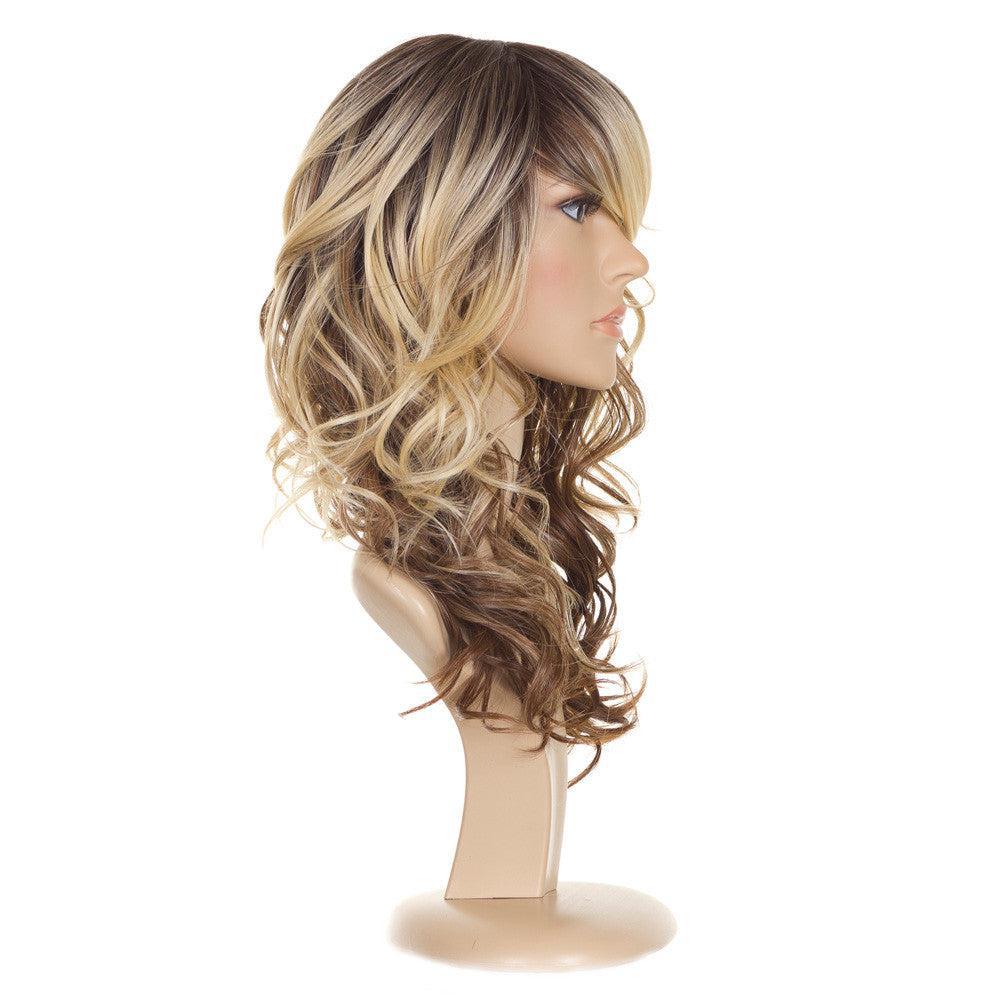Understanding Wig Types
Wigs come in two main types: human hair and synthetic. Human hair wigs are made from real human hair, offering a natural look and feel. They come in various types, including Chinese, Indonesian, Indian, and European hair. These wigs can be styled, cut, and colored just like your own hair, providing versatility and a realistic appearance.
The quality of human hair wigs can vary depending on the source and processing methods used, with virgin hair (hair that has never been chemically treated) being the highest quality and most expensive option.
Synthetic wigs are made from artificial fibers like Kanekalon and Toyokalon. These wigs are pre-styled and maintain their shape even after washing. They're often more affordable and require less maintenance than human hair wigs.
While they may not feel as natural as human hair, modern synthetic wigs can look very realistic. Advances in synthetic fiber technology have led to the development of heat-resistant fibers, allowing for limited heat styling options on some synthetic wigs.
Both types of wigs have their pros and cons, and the choice between them depends on your personal needs, budget, and lifestyle. Factors such as durability, styling versatility, and overall appearance play crucial roles in determining which type of wig is best suited for an individual.
Key Differences: Human Hair vs Synthetic Wigs
- Lifespan: Human hair wigs last 1-3 years, synthetic wigs 4-6 months
- Styling: Human hair wigs offer more versatility in styling and coloring
- Appearance: Human hair wigs look and feel more natural
- Maintenance: Synthetic wigs are easier to maintain
- Cost: Human hair wigs are generally more expensive


Appearance and Feel
Human hair wigs are prized for their natural look and movement. They blend seamlessly with your own hair and can be styled in countless ways. The texture and shine of human hair wigs closely mimic natural hair, making them virtually indistinguishable from real hair. This natural appearance is especially important for those dealing with hair loss or thinning. Human hair wigs also offer a more realistic scalp appearance, particularly in lace front or full lace constructions, where individual hairs appear to be growing directly from the scalp.
Synthetic wigs have come a long way in recent years. While they may not feel exactly like human hair, they can look very realistic. One advantage of synthetic wigs is their "style memory." They hold their style even after washing, which means less daily styling time. However, they may have a slightly shinier appearance than human hair wigs, which some users find less natural-looking. The fiber quality in synthetic wigs can vary greatly, with higher-end synthetics offering a more natural look and feel compared to budget options. Some synthetic wigs now incorporate a mix of different fiber types to create a more multidimensional, natural appearance.
The choice between human hair and synthetic wigs often comes down to personal preference and how natural you want your wig to look and feel. Factors such as hair density, texture, and the wig's construction method also play significant roles in the overall appearance and feel of both human hair and synthetic wigs.


Styling Options
Human hair wigs offer the most styling versatility. You can use heat tools like flat irons and curling wands, just as you would with your natural hair. They can be colored, permed, and cut to suit your preferences. This flexibility allows you to change your look as often as you like, making human hair wigs a favorite for those who enjoy experimenting with different styles. The ability to color human hair wigs is particularly advantageous, allowing users to match their natural hair color or try out new shades without committing to permanent hair dye.
Synthetic wigs have more limited styling options. Traditional synthetic wigs can't be heat-styled, as high temperatures can damage the fibers. However, heat-friendly synthetic wigs are available that can withstand temperatures up to 350°F. These allow for some styling flexibility, but still not as much as human hair wigs. Synthetic wigs are best for those who prefer a "wash and wear" option with minimal styling needs. Some synthetic wigs come pre-styled with popular haircuts and styles, making them an excellent choice for those who want a consistent look without daily styling efforts.
If you enjoy changing your hairstyle frequently, a human hair wig might be the better choice. For those who prefer a low-maintenance option, a synthetic wig could be ideal. It's worth noting that some wig wearers choose to own both types, using synthetic wigs for everyday wear and human hair wigs for special occasions or when they want more styling options.

Durability and Lifespan
Human hair wigs typically last longer than synthetic wigs when properly cared for. With good maintenance, a human hair wig can last 1-3 years. Factors affecting longevity include how often you wear the wig, how you care for it, and the quality of the wig itself. Human hair wigs require more maintenance, including regular washing, conditioning, and styling, but this care helps extend their lifespan. The quality of the hair used in the wig also plays a significant role in its durability, with higher-quality hair generally lasting longer and maintaining its appearance better over time.
Synthetic wigs generally have a shorter lifespan, typically lasting about 4-6 months with regular wear. However, they require less maintenance than human hair wigs. The fibers in synthetic wigs can become frizzy or worn over time, especially if exposed to friction or heat. While they may not last as long, synthetic wigs are often more affordable, allowing for more frequent replacements. Some high-end synthetic wigs may last longer, up to a year or more with proper care, but this is still generally less than the lifespan of a human hair wig.
Consider your budget and how long you plan to use the wig when deciding between human hair and synthetic options. For those undergoing temporary hair loss due to medical treatments, a synthetic wig might be a suitable short-term solution. For individuals looking for a long-term hair replacement option, investing in a high-quality human hair wig could be more cost-effective over time.
Average Lifespan of Human Hair vs Synthetic Wigs
Cost Comparison
Human hair wigs are generally more expensive than synthetic wigs. The initial investment for a high-quality human hair wig can be significant, with prices ranging from $100 to over $1000. However, considering their longer lifespan, human hair wigs can offer good value over time. They also maintain their quality and appearance longer, which can justify the higher upfront cost for many users. The price of human hair wigs can vary greatly depending on factors such as hair quality, length, and cap construction. For example, a full lace human hair wig will typically be more expensive than a basic cap construction.
Synthetic wigs are more budget-friendly, typically ranging from $30 to $500. While they may need to be replaced more frequently, the lower cost makes them accessible to a wider range of users. For those who like to change their style often or are new to wearing wigs, synthetic options provide an affordable way to experiment with different looks. The price range for synthetic wigs can also vary based on factors like fiber quality and cap construction, with higher-end synthetics approaching the lower end of human hair wig pricing.
Your budget and how often you plan to wear the wig should guide your decision between human hair and synthetic options. It's also worth considering the long-term costs, including maintenance products and potential replacements, when making your decision. Some wig wearers find that having a mix of both synthetic and human hair wigs allows them to balance cost with versatility and longevity.
Wig Construction Types
Both human hair and synthetic wigs come in various construction types, each offering different benefits. Lace front wigs feature a thin lace strip at the hairline, creating a natural-looking transition from the forehead to the wig. This construction is popular for its realistic appearance and is available in both human hair and synthetic options. Lace front wigs allow for versatile styling options, particularly for pulling the hair away from the face.

Full lace wigs have lace covering the entire cap, allowing for versatile styling and parting options. These are often made with human hair and provide the most natural look, but they're also typically the most expensive. Full lace wigs are favored by those who want the most styling flexibility and the most natural appearance, as they can be parted anywhere and styled in various updos.
Monofilament caps feature a thin, flesh-colored mesh top that creates the illusion of hair growing from the scalp. This construction is excellent for those with complete hair loss, as it provides a very natural look. Monofilament caps can be found in both human hair and synthetic wigs and are particularly beneficial for creating a realistic parting and crown area.

Wefted caps are the most common and cost-effective option. They're machine-stitched and less expensive, making them a good choice for those on a budget or new to wearing wigs. While wefted caps may not offer the same level of styling versatility as lace or monofilament options, they can still provide a natural look, especially when combined with a lace front.
Choosing the Right Wig for You
Selecting between human hair and synthetic wigs depends on various factors. Consider your lifestyle - if you're active or live in a humid climate, a synthetic wig might be more practical. For those who enjoy styling their hair or need a wig for long-term use, a human hair wig could be the better choice. Think about how much time you're willing to dedicate to wig maintenance and styling, as this can significantly influence your decision.
Budget is another crucial factor. While human hair wigs are more expensive upfront, they can be more cost-effective in the long run if you plan to wear a wig daily. Synthetic wigs are great for occasional use or if you like to change your style frequently. Consider your long-term needs and whether investing in a higher-quality wig initially might save money over time.
Think about the look you want to achieve. If you're after the most natural appearance and versatility in styling, human hair wigs are hard to beat. For low-maintenance, consistent style, synthetic wigs are an excellent option. Consider trying on different types of wigs to see which feels most comfortable and natural to you. Many wig retailers offer consultations to help you find the perfect wig for your needs and preferences.

Conclusion
Both human hair and synthetic wigs have their place in the world of hair alternatives. Human hair wigs offer unparalleled natural look and styling versatility but require more maintenance and come at a higher cost. Synthetic wigs provide convenience, affordability, and consistency in style, making them ideal for many users. The choice between the two often comes down to personal preferences, lifestyle needs, and budget considerations.
Remember, the best wig for you is one that makes you feel confident and comfortable. Whether you choose human hair or synthetic, proper care and maintenance will help your wig look its best and last longer. Consider trying both types to see which suits your needs and preferences best. Many wig wearers find that having a combination of both human hair and synthetic wigs gives them the most flexibility for different occasions and styling needs.
At CelebWigs, we offer a wide range of both human hair blend wigs and synthetic wigs to suit every need and budget. Our collection includes everything from celebrity-inspired styles to trendy ombre wigs, ensuring you'll find the perfect wig to express your unique style. We understand that choosing a wig is a personal decision, and our team is here to help guide you through the process, providing expert advice and support to ensure you find the perfect wig for your needs.




